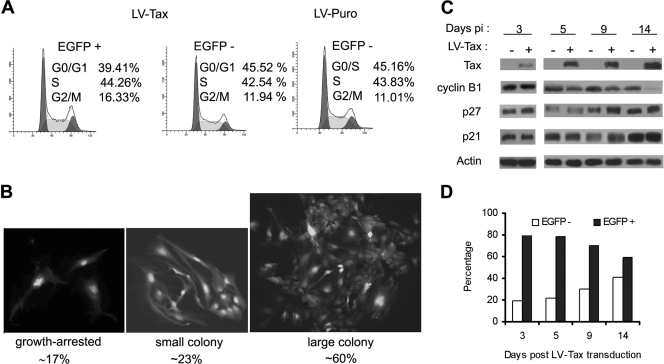FIG. 4.
LV-Tax-transduced HOS cells escape G1 arrest but develop mitotic abnormalities. (A) HOS cells escaped Tax-induced G1 arrest. HOS/18x21-EGFP cells were transduced with the LV-Tax vector as previously described (45) to achieve at least 80% gene transduction. The transduced cells were then subjected to flow cytometry as described in the legend to Fig. 3A. EGFP +, EGFP positive; EGFP −, EGFP negative. (B) LV-Tax-transduced HOS cells continued to proliferate and formed colonies. LV-Tax-transduced cells were seeded on 10-cm plates as described in the legend to Fig. 3B and allowed to grow for 6 days. EGFP-positive clusters/colonies were separated into three groups based on their sizes as indicated (growth arrested, small colony, and large colony) and counted. The percentage in each group was calculated. The numbers listed are derived from the results of two independent experiments. (C) Immunoblot of HOS cells transduced with LV-Tax at different times after gene transduction. Cell lysates were prepared from tax-transduced cells at the indicated times postinfection (Days pi) and immunoblotted (+) with Tax, cyclin B1, p27KIP1 (p27) p21CIP1/WAF1 (p21), and actin antibodies as shown. (D) LV-Tax-transduced HOS/18x21-EGFP cells were propagated in culture over a course of 2 weeks. The percentages of EGFP-positive (solid bars) and EGFP-negative (open bars) populations were determined by flow cytometry and plotted.

